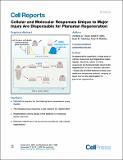Cellular and Molecular Responses Unique to Major Injury Are Dispensable for Planarian Regeneration
Author(s)
Tewari, Aneesha Gandhi; Stern, Sarah R.; Oderberg, Isaac Max; Reddien, Peter
Download1-s2.0-S2211124718317339-main.pdf (8.220Mb)
PUBLISHER_CC
Publisher with Creative Commons License
Creative Commons Attribution
Terms of use
Metadata
Show full item recordAbstract
The fundamental requirements for regeneration are poorly understood. Planarians can robustly regenerate all tissues after injury, involving stem cells, positional information, and a set of cellular and molecular responses collectively called the “missing tissue” or “regenerative” response. follistatin, which encodes an extracellular Activin inhibitor, is required for the missing tissue response after head amputation and for subsequent regeneration. We found that follistatin is required for the missing tissue response regardless of the wound context, but causes regeneration failure only after head amputation. This head regeneration failure involves follistatin-mediated regulation of Wnt signaling at wounds and is not a consequence of a diminished missing tissue response. All tested contexts of regeneration, including head regeneration, could occur with a defective missing tissue response, but at a slower pace. Our findings suggest that major cellular and molecular programs induced specifically by large injuries function to accelerate regeneration but are dispensable for regeneration itself. In regenerative organisms, a large array of cellular responses are triggered at major injuries. However, which of these responses are fundamentally required for regeneration to occur remains unknown. Tewari et al. find that hallmark cellular and molecular responses induced uniquely at large injuries are dispensable for planarian regeneration. Keywords: regeneration; wound response; WnT signaling; TGF-β signaling; planarians; follistatin
Date issued
2018-11Department
Massachusetts Institute of Technology. Department of BiologyJournal
Cell Reports
Publisher
Elsevier
Citation
Tewari, Aneesha G. et al. “Cellular and Molecular Responses Unique to Major Injury Are Dispensable for Planarian Regeneration.” Cell Reports 25, 9 (November 2018): 2577–2590 © 2018 The Author(s)
Version: Final published version
ISSN
2211-1247